Clipart tagged: ‘javelin’

A Roman Soldier, or Legionary, with a Short Javelin and Shield
Illustration of a Roman soldier, also called a legionary, carrying a shield, short sword, and a short…
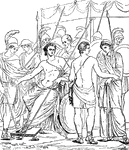
The Parting of Achilles and Briseis
"The Parting of Achilles and Briseis. (Supposed to be from a Greek Painting.)" —D'Anvers, 1895

Acontium
"a dart or javelin, smaller and lighter than the long spear, and thrown by means of a thong, or amentum"-Whitney,…

Frankish Weapons, Including a Shield, Germanic Spear, Angon, Sword, Knife, and Short Axe
A collection of weapons used by the Germanic tribe called the Franks. These are all of their most typically…
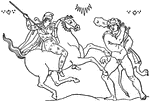
Hippolyta and the girdle
"Hippolyta, the queen, received him kindly, and consented to yield her girdle, but Juno, taking the…
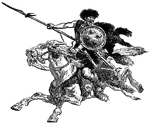
Hun Warrior on Horseback in Battle
Illustration of a Hun warrior riding on horseback, his mouth open as if to scream. The warrior has a…
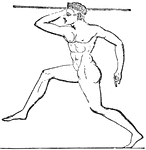
Hurling the javelin
"The Olympic games were of greater efficacy than the Amphictyonic Council in promoting the spirit of…
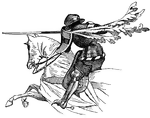
A Knight on Horseback, Wearing a Woman's Sleeve as a Favor
Illustration of a knight, riding a horse at full gallop, carrying a javelin and wearing full armor.…

Knight Riding Horse & Holding a Lance
An illustration of a knight riding a horse and holding a lance.

Two Knights Jousting with Lances
An illustration of two knights jousting with lances, shields, and armor.

Man and Horse
An illustration of a man riding a horse toward a windmill with a makeshift javelin, a play on Don Quixote.

A Roman Legionary
"From a monument of the imperial age. The soldier wears a metal helmet, a leather doublet with shoulder-pieces,…

Saul Tries to Kill David with His Javelin
"And an evil spirit from Jehovah was upon Saul, as he sat in his house with his spear in his hand; and…

Hunting Spears from the 15th or 16th Century
"A weapon consisting of a penetrating head attached to a long shaft of wood, designed to be thrust by…
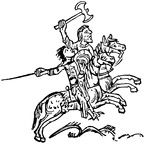
Two Anglo-Saxon Warriors on Horseback
Illustration of a drawing in The Harley Psalter, an illuminated manuscript of the second and third decades…
